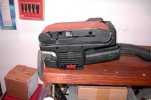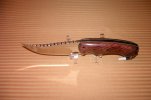I have made a few scales using the dremel rotary work station, Its not the best tool for the job, mainly because the adjustment knobs are not very sturdy and will cause the dremel to skew slightly to one side or the other. You can start drilling a hole dead center and next thing you know its off by a fraction (or more) of a millimeter. although not a big deal with larger holes, Small holes that need to be precisely aligned can be quite a challenge. and then if you are going to try to countersink screws you cant count on the whole unit not shifting.
The size of the bits that you can use is also limited to the maximum size dremel tools accept, they sell a separate chuck, but it only opens up a little more. This can be a problem when drilling larger holes like the ones for the pivot.
I ruined a few pairs on account of inexperience and a flimsy press. Despite that I managed to turn out exactly 2 pairs of scales that fit perfectly without any sloppy fixes.
My advice, get a real vertical drill press if you are thinking about turning out a few decent scales, or if you don't want to screw up a few projects on account of sketchy tools.






